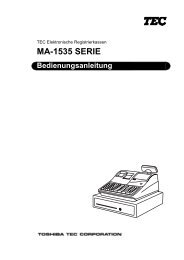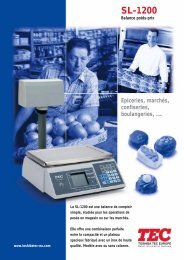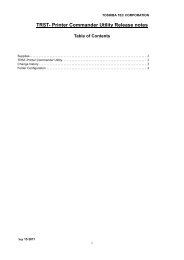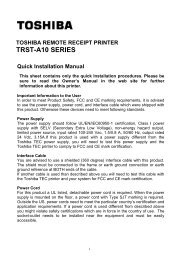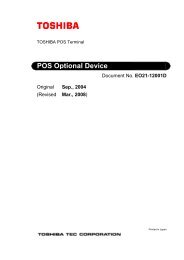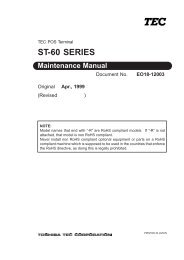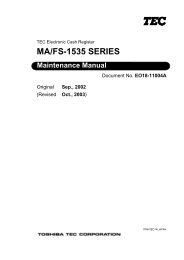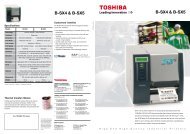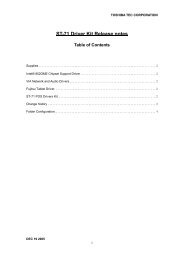1. outline - toshiba tec europe
1. outline - toshiba tec europe
1. outline - toshiba tec europe
You also want an ePaper? Increase the reach of your titles
YUMPU automatically turns print PDFs into web optimized ePapers that Google loves.
<strong>1.</strong> OUTLINE EO10-13009A<strong>1.</strong>6 ELECTRONIC SPECIFICATIONS(4) DSRWhen the DTR/DSR control is selected, the printer confirms this signal is SPACE and thensends the status data. When it is not selected, the data is sent without DSR.(5) SGSignal ground.(6) CTSClear to send. This is asserted by host terminal to acknowledge RTS and allow printer totransmit.Pin 2 - Transmitted Data (TxD) This signal is active when data is transmitted from the DTE(computer)device to the DCE (printer)device. When no data is transmitted, the signal is held in the markcondition(logic '1', negative voltage).NOTE: Pin 2 on the DCE device is commonly labeled "Received Data", although by theEIA232 standard it should still be called Transmitted Data because the data is thought to bedestined for a remote DTE device.Pin 3 - Received Data (RxD) This signal is active when the DTE device receives data fromthe DCE device. When no data is transmitted, the signal is held in the mark condition (logic '1',negative voltage).NOTE: Pin 3 on the DCE device is commonly labeled "Transmitted Data", although by theEIA232 standard it should still be called Received Data because the data is thought to arrivefrom a remote DTE device.Pin 4 - Request to Send (RTS) This signal is asserted (logic '0', positive voltage) to preparethe DCE device for accepting transmitted data from the DTE device. Such preparation mightinclude enabling the receive circuits, or setting up the channel direction in half-duplexapplications. When the DCE is ready, it acknowledges by asserting Clear to Send.NOTE: Pin 4 on the DCE device is commonly labeled "Clear to Send", although by the EIA232standard it should still be called Request to Send because the request is thought to bedestined for a remote DTE device.Pin 5 - Clear to Send (CTS) This signal is asserted (logic '0', positive voltage) by the DCEdevice to inform the DTE device that transmission may begin. RTS and CTS are commonlyused as handshaking signals to moderate the flow of data into the DCE device.NOTE:Pin 5 on the DCE device is commonly labeled "Request to Send", although by theEIA232 standard it should still be called Clear to Send because the signal is thoughtto originate from a remote DTE device.1-11





